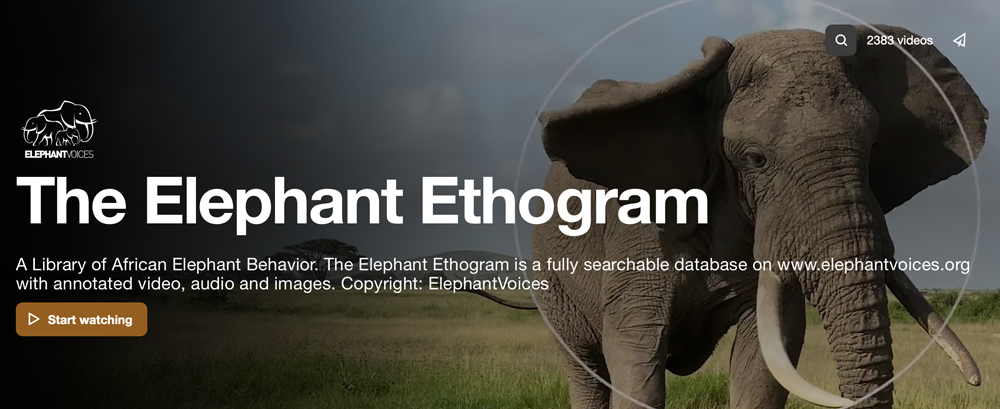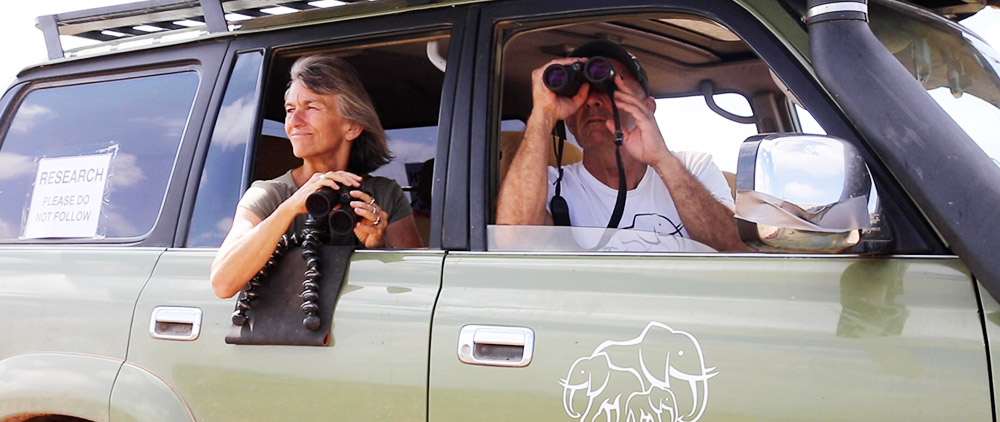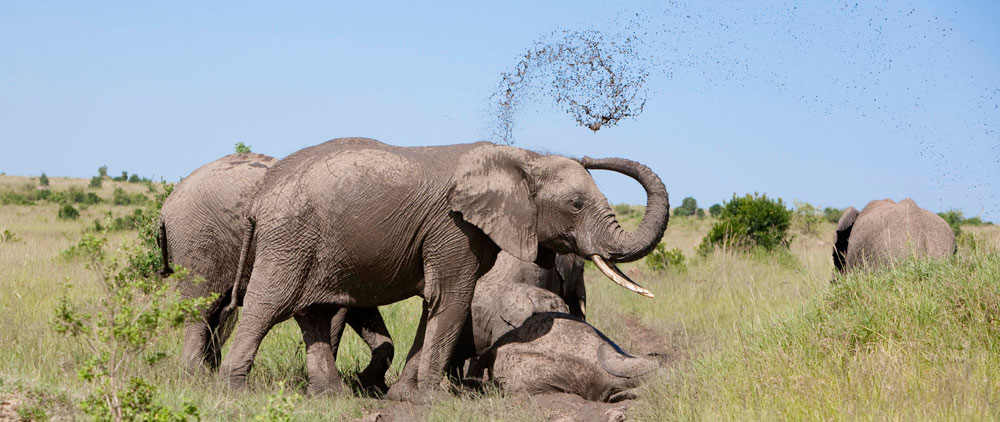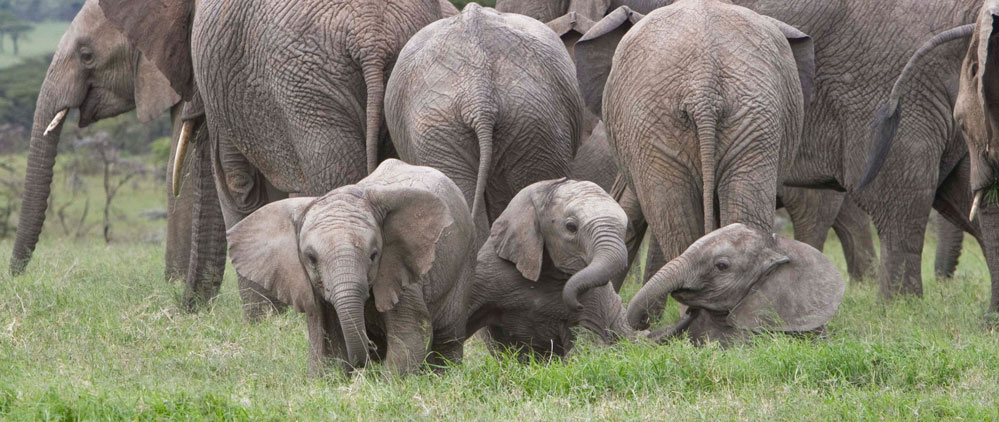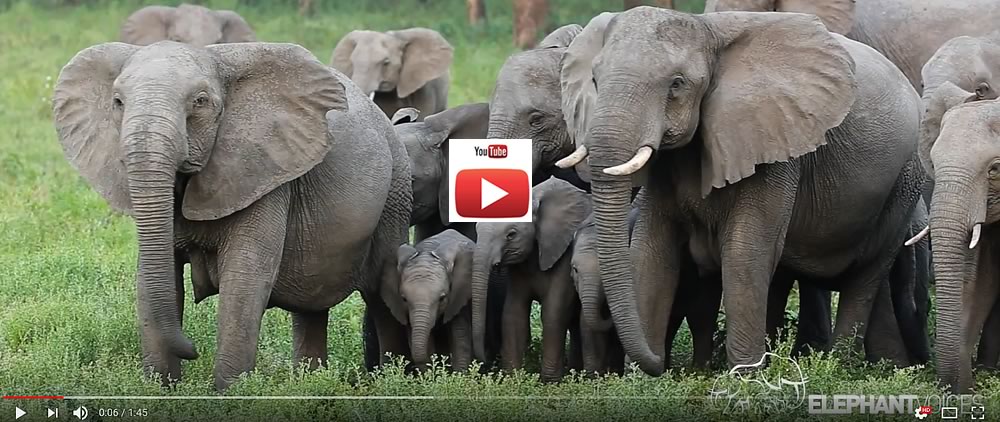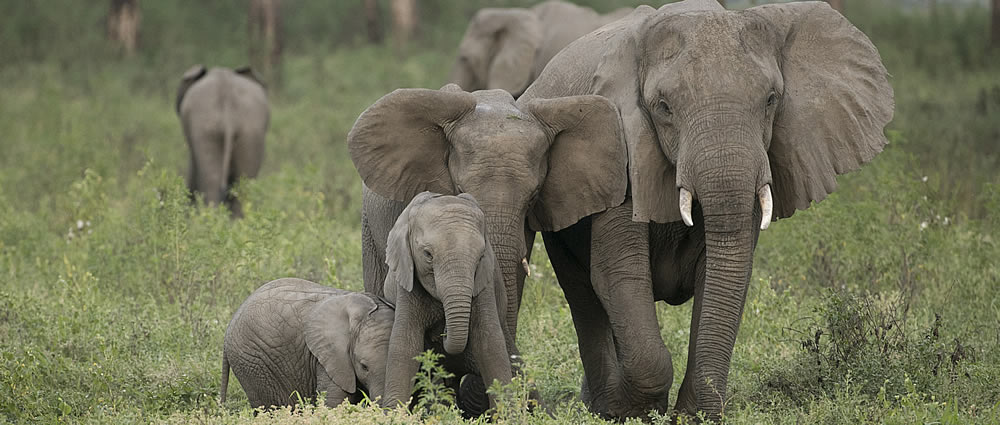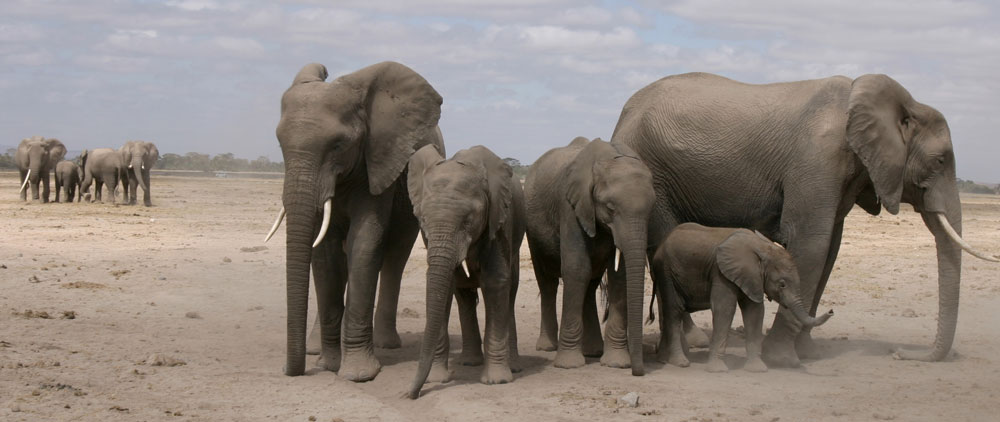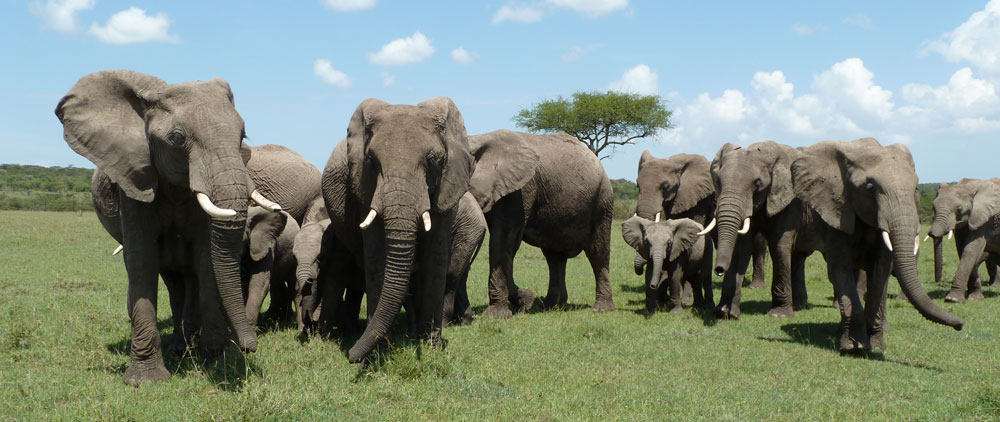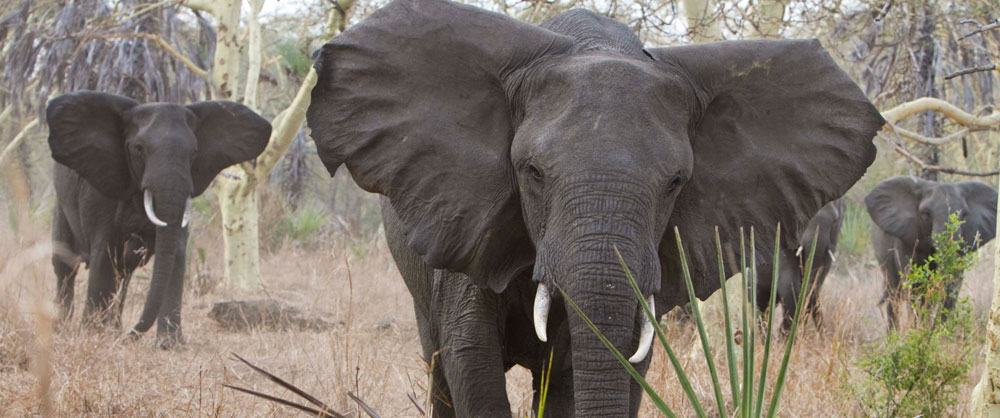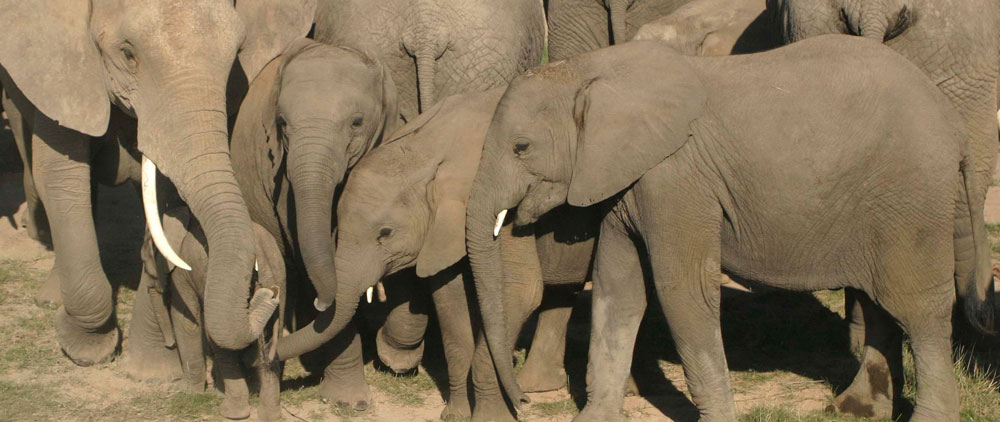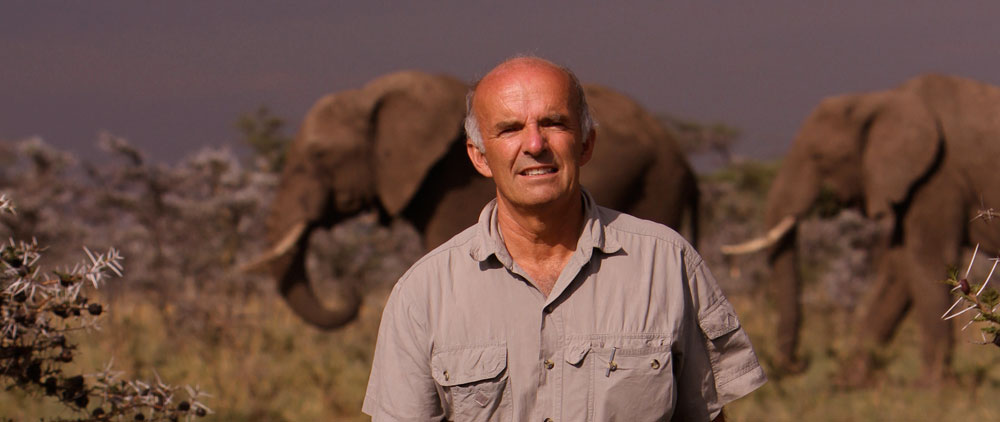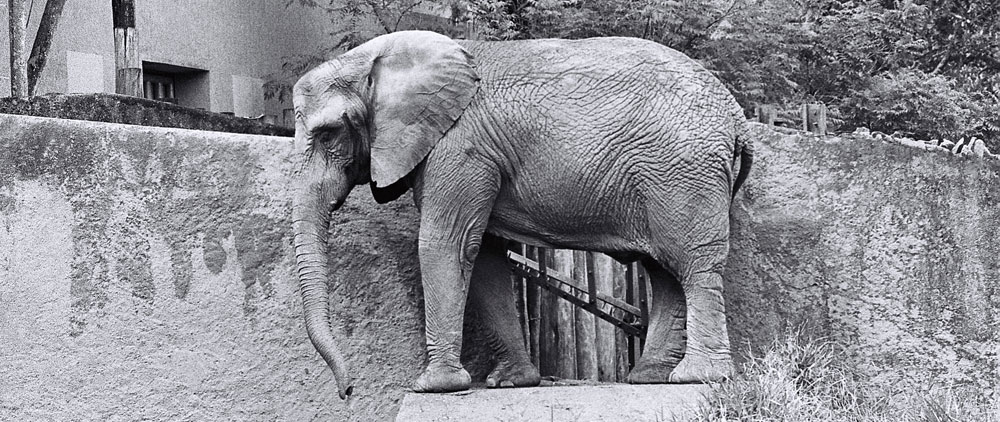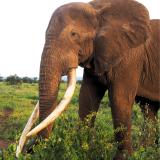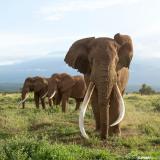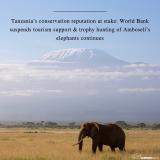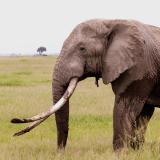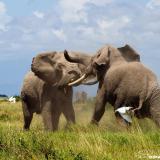Below you will find ElephantVoices' main references, listed in alphabetical order. (Updated October 2007) The list does not include references from the Elephant Interests section. Furthermore, references are included in many statements, papers and documents linked. You will find a complete list of AERP peer-reviewed publications here (upd. Oct. 2007), and a similar list for Joyce Poole here.
Abstracts from the African Elephant Bibliography are linked from each paper listed, if available. Read this if you want to know where to find the complete documents.
References within ElephantVoices' Why, How and What sections are numbered and linked from within respective section/database.
- Adams, J. & J.K. Berg. 1980. Behavior of female African elephants (Loxodonta africana) in captivity.
Appl. Anim. Ethol. 6: 267-276. Abstract. - Adamson, G. 1968. Bwana Game. Collins. Abstract.
- Afolayan, T.A. 1975. Effects of elephant activities on forest plantations in the Kilimanjaro forest-game reserve in northern Tanzania. Oikos 26:445-410. Abstract.
- Amboseli Elephant Research Project, long-term records.
- Balfour, D. & S. Balfour. 1997. African Elephants: A Celebration of Majesty. Cape Town: Struik Publishers. 168 p. Abstract.
- Ben-Shahar, R. 1999. On the Trail of the Wild. Cologne, Germany: Könemann. 320 p. Abstract.
- Berg, J.K. 1983. Vocalizations and associated behaviours of the African elephant (Loxodonta africana) in captivity. Z. Tierpsychol 63:63-79. Abstract.
- Brown, R.E. 1985. The Primitive Ungulates: orders Tubulidentata, Proboscidea, and Hyracoidea. In: Brown, R.E. and D.W. McDonald (Eds). Social odours in mammals, Volume 1. Clarendon Press-Oxford 1985. Abstract.
- Buss, I.O. & J.A. Estes. 1971. The functional significance of the movements and position of the pinnae of the African elephant, Loxodonta africana. J Mammal 52 (1): 21-27. Abstract.
- Buss, I.O., Rasmussen, L.E. and Smuts, G. L. 1976. The role of stress and individual recognition in the function of the African elephant`s temporal gland. Mammalia 40: 437-451. Abstract.
- Buss, I.O. 1990. Elephant Life: Fifteen Years of High Population Density. Ames: Iowa State Univ. Press. 191 p. Abstract.
- Byrne, R.W. 1996. Relating brain size to intelligence in primates. In Modelling the early human mind (ed. P. A. Mellars & K. R. Gibson), pp. 49-56. Macdonald Institute for Archaeological Research, Cambridge. Abstract.
- Cozzi, B, S. Spagnoli, L. Bruno. 2001. An overview of the central nervous system of the elephant through a critical appraisal of the literature published in the XIX and XX centuries. Brain Research Bulletin. 54 (2) 219-227. Abstract.
- Croze, H. 1972. The Seronera bull problem: I. The elephants. E. Afr. Wildl. J. 12:29-47. Abstract.
- Cutler, 1979. Abstract.
- Daniel, J.C. 1998. The Asian Elephant: a Natural History. Dehra Dun, India: Natraj Publishers. Abstract.
- Denhardt et al. 1997. Abstract.
- Deraniyagala, P.E.P. 1955. Some Extinct Elephants, Their Relatives and the Two Living Species, Ceylon Museums Publication. Government Press, Ceylon. Abstract.
- Dneprovskaya, I.A. Iofe, V.K. & F.I. Levitas. 1963. On the attenuation of sound as it propogates through the atmosphere. Sov. Phys. Acoust. 8: 235-239. Abstract.
- Douglas-Hamilton, I. 1972. On the Ecology and Behaviour of the African Elephant, D. Phil. Thesis, University of Oxford. Abstract.
- Douglas-Hamilton, I. 1973. On the ecology and behaviour of the Lake Manyara elephants.
E. Afr. Wildl. J. 11:401-3. Abstract. - Douglas-Hamilton, I. & O. Douglas-Hamilton. 1975. Among the Elephants. Viking Press, New York. Abstract.
- Douglas-Hamilton, I. & O. Douglas-Hamilton. 1992. Battle for the Elephants. Doubleday, London. Abstract.
- Dublin, H.T. 1983. Cooperation and reproductive competition among female African elephants. In: Social Behavior of Female Vertebrates. Ed: Wasser, S. Academic Press: pp 291-313. Abstract.
- Dunbar, R.I.M. 1992. Neocortex size as a constraint on group size in primates. Journal of Human Evolution, 20, 469-493. Abstract.
- Eltringham, S.K. 1982. Elephants. Blandford Press. Abstract.
- Eltringham, S. Keith. 1992. Longevity and Mortality. In: Elephants. Ed: Shoshani J. Weldon Owen: San Francisco. P 116-23. Abstract.
- Eisenberg, J.F., G.M. McKay & M.R. Jainudeen. 1971. Reproductive behaviour of the Asiatic elephant (Elephas maximus L.). Behaviour, 38:193-225. Abstract.
- Eisenberg, J.F. & M. Lockhart. 1972. An ecological reconnaissance of Wildpattu National Park. Smithsonian Cont. Zool. 101, p.1-117. Abstract.
- Eisenberg, J.F. 1983. The Mammalian Radiations: An Analysis of Trends in Evolution, Adaptation and Behavior. University of Chicago Press.Abstract.
- Estes, R.D. 1991. The Behavior Guide to African Mammals. University of California Press, Los Angeles. Abstract.
- Eyring, C.F. 1946. Jungle acoustics. J. Acoust. Soc. Am. 18:257-270. Abstract.
- Fischer, M.S. 1990. The unique ear of elephants and manatees (Mammalia): A phylogenetic paradox.
C.R. Acad. Sci. Ser. III: Sciences de la vie 331(4): 157-162. Abstract. - Gallup, Gordon Jr., James R. Anderson and Daniel J. Shillito. 2002. "The Mirror Test." In, The Cognitive Animal: Empirical and Theoretical Perspectives on Animal Cognition pp. 325-33. Eds: Marc Bekoff, Colin Allen, and Gordon M. Burghardt. Cambridge: Bradford Books. Abstract.
- Garstang, M., D. Larom, R. Raspet & M. Lindeque. 1995. Atmospheric controls on elephant communication.
J. Experimental Biol. 198:939-951. Abstract. - Greaves, N. 1996. Hwange: Retreat of the Elephants. Halfway House, South Africa: Southern Book Publishers. 134 p. Abstract.
- Grzimek, B. 1956. Ein merkwudiges Verhalten von Afikanischen Elefanten. Z. Tierpsychol. 13:151-152. Abstract.
- Grimshaw, J.M. & C.A.H. Foley. 1990. Kilimanjaro Elephant Project: Final Report to Friends of Conservation. Unpublished Report. Abstract.
- Guggisberg, C.A.W. 1956. Riesentiere und zwergmenschen. Hallwag Bern. Abstract.
- Hall-Martin, A. J. & L.A. Van der Walt. 1984. Plasma testosterone levels in relation to musth in the male African elephant. Koedoe, 27, 147-149. Abstract.
- Hall-Martin, A.J. 1987. Role of musth in the reproductive strategy of the African elephant (Loxodonta africana). S. Afr. J. Sci. 83:616-20. Abstract.
- Hanks, J. 1972b. Reproduction of the elephant, Loxodonta africana in the Luangwa Valley, Zambia. J. Reprod. Fert. 30: 13-26. Abstract.
- Hart, B., L.A. Hart, M. McCoy & C.R. Sarath. 2001. Cognitive behaviour in Asian elephants: use and modification of branches for fly switching. Anim Behav 62:839-847. Abstract.
- Heffner, S.R. & E.H. Heffner. 1982. Hearing in the elephant (Elephas maximus): absolute sensitivity, frequency discrimination, and sound localization. J. Comp. Phys. Psych. 96:926-44. Abstract.
- Heffner, R.S., H.E. Heffner & N. Stichman. 1982. The role of elephant pinna in sound localization. Anim. Behav. 30: 628-629. Abstract.
- Hendrichs, H. 1971. Freilandbeobachtungen zum Sozial-system des Africanischen Elephanten, Loxodonta africana. In: Dikdik und Elephanten, Piper, Munich. Abstract.
- Ingard, U. 1953. A review of the influence of meteorological conditions on sound propogation. J. Acoust. Soc. Am. 25:405-411. Abstract.
- Irwin, T.E. 1963. Elephant's stomach rumbles. African Wildlife. 17(2): 112. Abstract.
- Jainudeen, M.R., Eisenberg, J.F., and N. Tilakeratne. 1971. Oestrous cycle of the Asiatic Elephant, Elephas maximus, in Captivity. Journal of Reprod. Fert. 27:321-328. Abstract.
- Jainudeen, M.R., G.M. McKay & J.F. Eisenberg. 1972. Observations on musth in the domesticated Asiatic elephant. Mammalia 36, p. 247-261. Abstract.
- Jayewardene, J. 1994. The Elephant in Sri Lanka. Colombo: Wildlife Heritage Trust of Sri Lanka. 128 p. Abstract.
- Jerison, H.J. 1973. Evolution of the Brain and Intelligence. New York: Academic Press. Abstract.
- Kahl, M.P. & B.D. Armstrong. 2000. Visual and tactile displays in African elephants, Loxodonta africana:
A progress report (1991-1997). Elephant 2 (4): p. 19-21. Abstract. - Kahl, M.P. & B.D. Armstrong. 2002. Visual displays of wild African elephants during musth. Mammalia 66:159-171. Abstract.
- Krishnan, M. 1972. An ecological survey of the larger mammals of peninsular India. The Indian elephant. Journal of the Bombay Natural History Society, 69(2): 297-321. Abstract.
- Kühme, V.W. 1961. Beobachtungen am africanschen Elephanten (Loxodonta africana Blumenbach 1797) in Gefangenschaft. Z. Tiersychol 18:285-96. Abstract.
- Kühme, V.W. 1962. Ethology of the African elephant. Int. Zoo. Yearbook 4: 113-121. Abstract.
- Kühme, W. 1963. Ergänzende Beobachtungen an afrikanischen Elephanten (Loxodonta africana Blumenbach 1797) im Freigehege (2.Teil). Zeitschrift für Tierpsychologie, 20(1): 66-79. Abstract.
- Lahiri-Choudhury, D.K. (Editor) 1999. The Great Indian Elephant Book: An Anthology of Writings on Elephants in the Raj. New Delhi: Oxford University Press. 459 p. Abstract.
- Lamps, L.W., Smoller, B.R., Rasmussen, L.E.L., Slade, B.E., Fritsch, G. and T.E. Goodwin. 2001. Characterization of interdigital glands in the Asian elephant (Elephas maximus). Research in Veterinary Science. 71: 197-200. Abstract.
- Langbauer Jr., W.R., K.B. Payne, R.A. Charif & E.M. Thomas. 1989. Responses of captive African elephants to playback of low-frequency calls. Can. J. Zool. 67:2604-2607. Abstract.
- Langbauer Jr., W.R., K.B. Payne, R.A. Charif, L. Rapaport & F. Osborn. 1991. African elephants respond to distant playbacks of low-frequency conspecific calls. J. Experimental Biol. 157: 35-46. Abstract.
- Langbauer Jr., W.R. Jr. 2000. Elephant Communication. Zoo Biology 19:425-445. Abstract.
- Larom, D., M. Garstang, K. Payne, R. Raspet & M. Lindeque. 1997. The influence of surface atmospheric conditions on the range and area reached by animal vocalizations. J. Experimental Biol. 200: 421-431. Abstract.
- Lazar, J., Greenwood, D.R., Rasmussen, L.E.L. and G.D. Prestwich. 2002. Molecular and functional characteristics of an odorant binding protein of the Asian Elephant, Elephas maximus: Implications for the role of lipocalins in mammalian olfaction. Biochemistry 41: 11786-11794. Abstract.
- Laws, R.M. 1966. Age criteria for the African elephant, Loxodonta a. africana. East Afr. Wildl. J. 4: 1-37. Abstract.
- Laws, R.M. & I.S.C. Parker. 1968. Recent studies on elephant populations in East Africa. Symp. Zool. Soc. Lond. 21:319-359. Abstract.
- Laws, R.M. 1969. The Tsavo Research Project. J. Repro. Fert. Supp. 6: 495-531. Abstract.
- Lee, P.C. and C.J. Moss. 1986. Early maternal investment in male and female elephant calves. Behav. Ecol. Sociobiol. 18:353-361. Abstract.
- Lee, P.C. 1986. Early social development among African elephant calves. Natl. Geogr. Res. 2:388-401. Abstract.
- Lee, P.C. 1987. Allomothering among African elephants. Anim Behav. 35:278-91. Abstract.
- Lee, P.C. 1989. Family structure, communal care and female reproductive effort. Comparative Socioecology. 8: 323-340. Abstract.
- Lee, P.C. & C.J. Moss. 1995. Statural growth in known-age African elephants (Loxodonta africana). J. Zool. (Lond.) 236: 29-41. Abstract.
- Lee, P.C. & C.J. Moss. 1999. The social context for learning and behavioural development among wild African elephants. In: Mammalian Social Learning: Comparative and Ecological Perspectives. Zool. Soc. Lond. Symp. 73. Abstract.
- Mariappa, D. 1986. Anatomy and Histology of the Indian Elephant (Indira Oak Park, MI.). Abstract.
- McComb, K., C. Moss, S. Sayialel & L. Baker. 2000. Unusually extensive networks of vocal recognition in African elephants. Anim. Behav. 59:1103-9. Abstract.
- McComb, K., C. Moss, S. Durant, S. Sayialel, L. Baker. 2001. Matriarchs as repositories of social knowledge. Science 292: 491-494. Abstract.
- McComb, K., D. Reby, L. Baker, C. Moss, & S. Sayialel. 2003. Long-distance communication of social identity in African elephants. Anim. Behav. 65:317-329. Abstract.
- McKay, G.M. 1973. Behaviour and ecology of the Asiatic elephant in Southeastern Ceylon. Smithsonian Contr. Zool. 125:1-113. Abstract.
- Meredith, M. 2001. Africa's Elephants: A Biography. Hodder and Staughton, London. Abstract.
- Morgan, B.J. and P.C. Lee. 2003. Forest elephant (Loxodonta africana cyclotis) stature in the Reserve de Faune du Petit Loango, Gabon. J. Zool. Lond. 259: 337-344. Abstract.
- Moss, C.J. 1981. Social Circles. Wildl. News. 16, 2-7. Abstract.
- Moss, C.J. 1982. Portraits in the Wild. 2nd Edition. University of Chicago Press, Chicago. Abstract.
- Moss, C. 1983. Oestrous behaviour and female choice in the African elephant. Behaviour 86:167-96. Abstract.
- Moss, C.J. & J.H. Poole. 1983 Relationships and social structure in African elephants. In: Primate Social Relationships: an Integrated Approach. Ed: Hinde, R.A. Blackwell Scientific Publications, Oxford: pp 315-325. Abstract.
- Moss, C. 1988. Elephant Memories. William Morrow & Company, Inc. New York. Abstract.
- Moss, C. 1992. Echo of the Elephants. BBC Books, London. Abstract.
- Moss, C. 1994. Some reproductive parameters in a population of African elephants, Loxodonta africana. Proceedings of the second international NCRR conference: 284-292. Bambra, C.H. (Ed). Nairobi: Institute of Primate Research. Abstract.
- Moss, C. 2001. The demography of and African elephant (Loxodonta africana) population in Amboseli, Kenya. J. Zool. Lond. 255: 145-156. Abstract.
- Nummela, S. 1995. Scaling of the mammalian middle ear. Hearing Research. 85: 18-30. Abstract.
- O'Connell, C., L. Hart B.T. & Arnason. 1999. Comments on "Elephant hearing". J. Acoust. Soc. Am. 105:2051-2052. Abstract.
- O’Connell-Rodwell, C., B.T. Arnason & L.A. Hart. 2000. Seismic properties of Asian elephant (Elephas maximus) vocalizations and locomotion. Acoust. Soc. Am. 108 (6) 3066-3072. Abstract.
- O’Connell-Rodwell, C., Wood, J.D., Kinzley, C., Rodwell, T.C., Poole, J.H., & Puria, S. 2007. Wild African elephants (Loxodonta africana) discriminate between familiar and unfamiliar conspecific seismic alarm calls. J. Acoust. Soc. Am. 122: 823-830.
- Payne, K.B., W.R. Langbauer Jr., E.M. Thomas. 1986. Infrasonic calls of the Asian elephant (Elephas maximus). Behav. Ecol. Sociobiol. 102:283-316. Abstract.
- Payne, K.B. & W.R. Langbauer Jr. 1992. Elephant communication. In: Elephants. Ed: Shoshani J. Weldon Owen: San Francisco. P 116-23. Abstract.
- Payne, K. 1998. Silent Thunder. Simon & Schuster, New York. Abstract.
- Payne, K. 2003. Sources of Social Complexity in the Three Elephant Species. In: Animal Social Complexity: Intelligence, culture and individualized society. Eds: Frans B.M. de Waal & Peter L. Tyack. Harvard University Press. Abstract.
- Perrin, T.E. and L.E.L. Rasmussen. 1994. Chemosensory responses of female Asian elephants (Elephas maximus) to cyclohexanone. Journal of Chemical Ecology 20(11): 2577-2586. Abstract.
- Poole, J.H. & C.J. Moss. 1981. Musth in the African elephant, Loxodonta africana. Nature, 292:830-831. Abstract.
- Poole, J.H. 1982. Musth and male-male competition in the African elephant. Ph.D. Thesis. University of Cambridge. Abstract.
- Poole, J.H., L.H. Kasman, E.C. Ramsey and B.L. Lasley. 1984. Musth and urinary testosterone concentrations in the African elephant (Loxodonta africana). J. Reprod. Fert., 70: 225-260. Abstract.
- Poole, J.H. 1987a. Rutting behavior in African elephants: the phenomenon of musth. Behaviour. 102: 283- 316. Abstract.
- Poole, J.H. 1987b. Elephants in musth, lust. Natural History. 96 (11): 46-55. Abstract.
- Poole, J.H. 1987c. Raging Bulls. Animal Kingdom 90 (6): 18-25. Abstract.
- Poole, J.H., K.B. Payne, W.R. Langbauer Jr., C.J. Moss. 1988. The social contexts of some very low frequency calls of African elephants. Behav. Ecol. Sociobiol. 22:385-392. Abstract.
- Poole, J.H. 1989a. Announcing intent: the aggressive state of musth in African elephants. Anim. Behav. 37: 140-152. Abstract.
- Poole, J.H. 1989b. Mate guarding, reproductive success and female choice in African elephants. Anim. Behav. 37: 842-849. Abstract.
- Poole, J.H. and C.J. Moss. 1989. Elephant mate searching: Group dynamics and vocal and olfactory communication. In: The Biology of Large African Mammals in their Environment. Eds: P.A. Jewell & G.M.O. Maloiy. Oxford: Clarendon Press. Proceedings of Sym. Zool. Soc. Lond. 61:111-125. Abstract.
- Poole, J.H. 1994. Sex differences in the behavior of African elephants. In: The Differences Between the Sexes. Eds: R. Short & E. Balaban. Cambridge University Press. Abstract.
- Poole, J.H. 1996. Coming of Age with Elephants. Hyperion Press, New York. Abstract.
- Poole, J. 1997. Elephants. WorldLife Library, Colin Baxter Photography Ltd., Scotland. Abstract.
- Poole, J.H. 1998. An exploration of a commonality between ourselves and elephants. Special Issue Etica & Animali. 9:85-110. Abstract.
- Poole, J.H. 1999a. Signals and Assessment in African Elephants: Evidence from playback experiments. Animal Behaviour, 58:185-193. Abstract.
- Poole, J.H. 1999b. Ella's Easter Baby. Care for the Wild Magazine. Abstract.
- Poole, J.H. 2000a. Family reunions. In: The Smile of the Dolphin: Remarkable Accounts of Animal Emotions, edited by Marc Bekoff. Discovery Books, New York. Abstract.
- Poole, J.H. 2000b. When Bonds are broken. In: The Smile of the Dolphin: Remarkable Accounts of Animal Emotions, edited by Marc Bekoff. Discovery Books, New York. Abstract.
- Poole and Granli. 2003. www.ElephantVoices.org.
- Poole, J. H. & Granli, P.K. 2004. The visual, tactile and acoustic signals of play in African savannah elephants. In: Endangered Elephants, past present & future. Jayewardene, Jayantha. (Ed.) Proceedings of the Symposium on Human Elephant Relationships and Conflicts, Sri Lanka, September 2003. Biodiversity & Elephant Conservation Trust, Colombo. Pages 44-50.
- Poole, J.H., Tyack, P.L., Stoeger-Horwath, A.S. & Watwood, S. 2005. Elephants are capable of vocal learning. Nature, 434: 455-456.
- Poole, J.H. In prep. Behavioural contexts and vocal communication of African savanna elephants. In: The Amboseli Elephants: A long-term perspective on a long-lived mammal. Eds. Cynthia Moss & Harvey Croze. University of Chicago Press, Chicago. Abstract.
- Poole, J.H., C.J. Moss, P.C. Lee. In prep. Male long-term reproductive strategies and musth. In: The Amboseli Elephants: A long-term perspective on a long-lived mammal. Eds. Cynthia Moss & Harvey Croze. University of Chicago Press, Chicago. Abstract.
- Poole, J.H. P.C. Lee, and C.J. Moss. In Prep. Independence and beyond. In: The Amboseli Elephants: A long-term perspective on a long-lived mammal. Eds. Cynthia Moss & Harvey Croze. University of Chicago Press, Chicago Abstract.
- Rasmussen, L.E.L., M.J. Schmidt, R. Henneous, D. Groves & G.D. Daves. 1982. Asian bull elephants: flehmen-like responses to extractable components in female elephant estrous urine. Science 217:159-162. Abstract.
- Rasmussen L.E.L., Buss, I.O., Hess, D.L., and M.J. Schmidt. 1984. Testosterone and dihydrotestosterone concentrations in elephant serum and temporal gland secretions. Biol. Reprod. 30:352-362. Abstract.
- Rasmussen, L.E.L., M.J. Schmidt & G.D. Daves. 1986. Chemical communication among Asian elephants. In: Chemical Signals in Vertebrates: Evolutionary, Ecological, and Comparative Aspects. Eds: Duvall, D., M. Silverstein, D. Muller-Schwarze. Plenum Press. 627-646. Abstract.
- Rasmussen, L.E.L. 1988. Chemosensory responses in two species of elephants to constituents of temporal gland secretion and musth urine. J. Chem. Ecol. 16:687-711. Abstract.
- Rasmussen, L.E.L., T.D. Lee, G.D. Daves & M.J. Schmidt. 1993. Female-male pheromones of low volatility in the Asian elephant, Elephas maximus. J. Chem. Ecol. 19:2115-2128. Abstract.
- Rasmussen, L.E.L. 1995. Evidence for long-term chemical memory in elephants. Chemical Senses. 20: 237-237. Abstract.
- Rasmussen, L.E.L., A. Hall-Martin & D.L. Hess. 1996. Chemical profiles of African bull elephants (Loxodonta africana); physiological and ecological implications. J. Mammalogy. 77:422-439. Abstract.
- Rasmussen, L.E.L. & B. Munger. 1996. The sensorimotor specializations of the trunk tip of the Asian elephant, Elephas maximus. The Anatomical Record 246:127-134. Abstract.
- Rasmussen, L.E.L. 1998. Chemical Communication: An integral part of functional Asian elephant (Elephas maximus) society. Ecoscience: 5(3): 410-426. Abstract.
- Rasmussen, L.E.L. & B.A. Schulte. 1998. Chemical signals in the reproduction of Asian (Elephas maximus) and Africana (Loxodonta africana) elephants. Animal Reproduction Science 53:19-34. Abstract.
- Rasmussen L.E.L. and B.A. Schulte. 1999. Ecological and biochemical constraints on pheromonal signaling systems in Asian elephants and their evolutionary implications. In: Johnston, R.E.; Muller-Schwarze, D; Sorenson, P.W., eds. Advances in chemical signals in vertebrates, Vol. 8. New York: Kluwer Academic/Plenum Publishers; 1999: 49-62. Abstract.
- Rasmussen, L.E.L. and T.E. Perrin. 1999. Physiological correlates of musth: lipid metabolites and chemical composition of exudates: Physiology and Behavior. 67(4): 539-549. Abstract.
- Rasmussen, L.E.L. 1999. Evolution of chemical signals in the Asian elephant, Elephas maximus: behavioural and ecological influences. Journal of Biosciences 24(2): 241-251. Abstract.
- Rasmussen, L.E.L. & V. Krishnamurthy. 2000. How chemical signals integrate Asian elephant society: he known and the unknown. Zoo Biology. 19:405-423. Abstract.
- Rasmussen, L.E.L., Riddle, H.S. and V. Krishnamurthy. 2002. Mellifluous matures to malodorous in musth. Nature. 415: 975-976. Abstract.
- Rasmussen, L.E.L. & G. Wittemyer. 2002. Chemosignaling of musth by individual wild African elephants (Loxodonta africana): implications for conservation and management. Proc. Royal. Soc. London. 269:853-860. Abstract.
- Rensch, B. 1956. Increase of learning capability with increase of brain-size. The American Naturalist. 40(851): 81-95. Abstract.
- Rensch, B. 1957. The Intelligence of elephants. Scientific American 196(2)-44-49. Abstract.
- Reuter T., S. Nummela & S. Hemila. 1998. Elephant Hearing. J. Acoust. Soc. Am. 104:1122-1123. Abstract.
- Riddle, H.S., S.W. Riddle, L.E.L. Rasmussen & T.E. Goodwin. 2000. The first disclosure and preliminary investigation of a liquid released from the ears of African elephants. Zoo Biology 19: 475-480. Abstract.
- Rossing, T.D. 1983. The Science of Sound. Addison-Wesley Publishing Company, Reading Massachusetts. Abstract.
- Roth, G. 1999. Kleine Gehirne - grobe gehirn. Evolutionare Aspekte und funktionelle konsequnzen. Naturwissenschaftliche Rundschau 52, p 213-219. Abstract.
- Sanderson, G.P. 1907. Thirteen Years Among the Wild Beasts of India, 6th ed. John Grant, Edinburgh. Abstract.
- Schaffer, J. 1940. Die Hautdrusenorgane der Saugetiere. Urban & Schwarzenberg, Berlin. Abstract.
- Schulte, B.A. and L.E.L Rasmussen. 1999. Signal-receiver interplay in the communication of male condition by Asian elephants. Animal Behaviour 57: 1265-1274. Abstract.
- Schulte, B.A., and L.E.L Rasmussen, 1999. Musth, sexual selection, testosterone, and metabolites. In: Johnston, R.E. (Ed.), Advances in Chemical Signals in Vertebrates 8. Kluwer Academic/Plenum Publishers, New York 1999. Chapter 33: 383-397. Abstract.
- Shoshani, J. and J. Eisenberg. 1992. Intelligence and Survival. In: Elephants: Majestic Creatures of the Wild. Edited by H. Shoshani. Abstract.
- Shoshani, J., A. Dalen, G. Watson, G.H. Marchant & E. Marsac. 1997. The pharyngeal pouch: a unique receptacle in the throat of an elephant. In: Proceedings of the 23rd National Conference of the American Association of Zoo Keepers, Inc. pp 14-24. American Association of Zoo Keepers, Inc. Abstract.
- Shoshani, J. 1997. It’s a nose! It’s a hand! It’s an elephant’s trunk! Natural History. Abstract.
- Shoshani, J. 1998. Understanding proboscidean evolution: a formidable task. TREE 13: 480-487. Abstract.
- Sikes, S. 1971. The Natural History of the African Elephant. Weidenfeld & Nicolson, London. Abstract.
- Simonet, P. M., Myers, L., Lamoureux, J., Quashnick, J., Jacobs, K., Willison. 2000. Social and Cognitive Factors in Asian Elephant Mirror Behaviour and Self-Recognition. Paper presented at the Animal Social Complexity & Intelligence. Chicago Academy of Sciences, August 23-26, 2000. Abstract.
- Spinage, C.A. 1994. Elephants. T & AD Poyser, London. Abstract.
- Sukumar, R. 1989. The Asian Elephant: Ecology and Management. Cambridge University Press, Cambridge. Abstract.
- Sukumar, R. 1994. Elephant Days and Nights: Ten Years with the Indian Elephant. Oxford University Press, New Delhi. Abstract.
- Tennent, J.E. 1867. The wild elephant, and the method of capturing and taming it in Ceylon. Longmans, London, Green. 198 pp. Abstract.
- Turkalo, A. 1996. Studying forest elephants by direct observation in the Dzanga clearing: An update. Pachyderm. 22:59-60. Abstract.
- Verheyen, R. 1954. Elements pour une monographie ethologique de l'Elephant d'Afrique, Loxodonta africana Blumenbach. Bull Inst. Royal Col. Belge 30: 1-19. Abstract.
- Viljoen, A.J. 1990. The use of video digitized aerial photographs and image processing techniques for resource management in the Kruger National Park, South Africa. In: proceedings: Resource Ecology 90, Second International Symposium on Advanced Technology in Natural Resource Management. Washington, D.C., 12-15 Nov. 1990. Abstract.
- Weilgart, L., H. Whitehead & K. Payne. 1996. A colossal convergence. American Scientist. 84: 278-287. Abstract.
- Western D., Moss, C.J., Georgiadis, N. 1983. Age estimation and population age structure of elephants from footprint dimensions. J. Wildl. Manag. 47: 1192-1197. Abstract.
- Wiley, R.H. & D.G. Richards. 1978. Physical constraints on acoustic communication in the atmosphere: implications for the evolution of animal vocalizations. Behav. Ecol. Sociobiol. 3: 69-94. Abstract.
African Elephant Bibliography.


